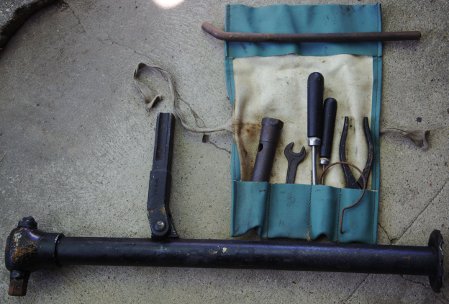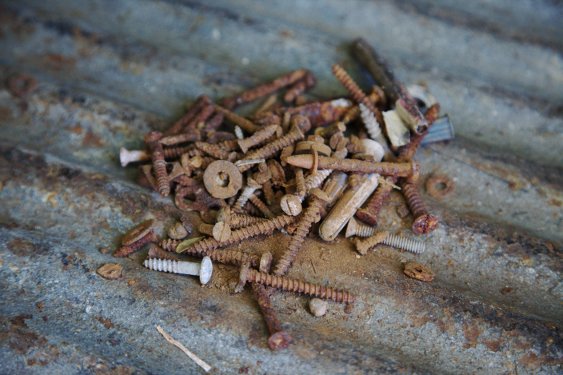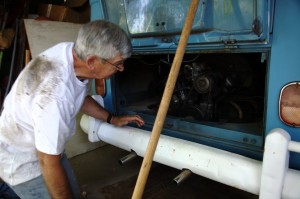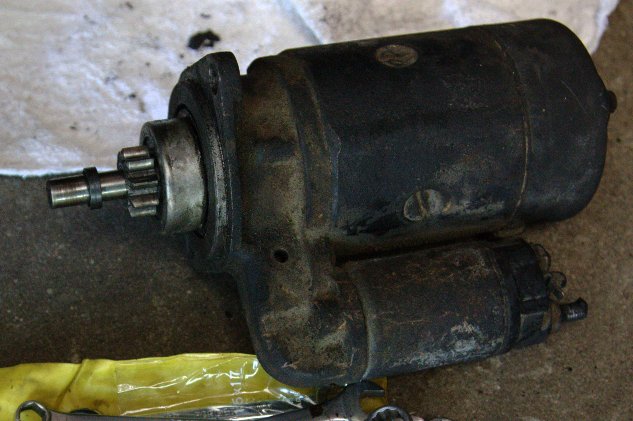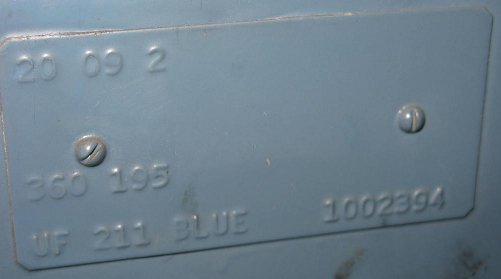Packages that arrived:
- From Wayne Johnson:
- 6/12v hybrid starter
- Wolfgang Int:
- 71-79 master cylinder
- vw rabbit reservoir
- converter kit (spacer + screws)
- Eastwood
- speed blaster
- Rust encapsulator
- bfyobsolete
- fuel line
- door latch
- rear window weatherstrip
- volkswagen rear emblem + clips
- 68 air cleaner
All 3 of my brothers were in town, Tom and Mom waited at the train station for almost an hour while the train was late due to begining at Jack London Square with a bum engine.
Had a nice talk catching up with Tom and got home to dinner and desert. Dad, Mom, Tom, and I talked as I unpackaged the parts that arrived. Soon Dad turned in and Mom, Tom, and I stayed up late talking and playing some of skate2. Matt and Jenny were sound asleep having traveled from Kasas City (M) and Will took off a few hours earlier being on
an earlier schedule.
Got to bed pretty late, but up early trying to get a start before the midwesterners, but they were up and about just after I got dressed. Grabbed a bagel, coffee, the new hybrid starter, and new air cleaner.
Dad showed up a few moments after I opened the garage and we set to work preping the parts for installation. The air cleaner fit but takes up a lot of space as others mentioned on the vintage bus list.
Once we were ready we put the starter back in, which went in a lot easier than pulling it because I found a good way of squeezing it in between the heater and break lines. Dad found a good way to get a socket on the long bolt that holds both the engine and the starter on and I was able to tighten it with a cresent from inside the engine compartment. I
found just how useful a head lamp is and really was thankful for choosing the more powerful LED version (1.5 watts made by Energizer). We couldn’t easily get out the bushing that is embedded in the transmission housing, so we inspected the old one and it looked good enough to leave in.
With the starter on we fired up the engine. It turned it over, but we had to really gun the gas to keep it alive. Since we didn’t have the air cleaner in we decided to turn it off so that we could get the air cleaner attached. Filled the bottom of the air cleaner with oil to the red line in the bottom, attached the neck, positioned it, put the air cleaner on the neck, tighted the hose clamps down on it and since we didn’t really have a place to hang it we used an old clothes hanger looped around the engine compartment roof support and twisted it around the air clearner at the point it connects to the neck with a pair of pliers.
In the back of my head I could hear my ex-coworker Mikey saying “Duck tape and bailing wire”, which was a common expression when we needed to improvise computer repairs. This was really the only option for hanging the air cleaner since this bus originally used a triangular bracket to support the air cleaner off of the coil. I’ve ordered a reproduction stale air cleaner bracket from Greg Noble and Clara Williams off thesamba.com. I’m thinking I can modify it to fit the current doghouse fresh-air fan shroud. Since it’s a repro I don’t feel too bad about modifying it.
We started the engine again and let it run much longer and my Dad grabbed a small screwdriver and adjusted the idle down to a much lower idle.
We rested for lunch and my brothers were talking about the Forestiere Underground Gardens tour, which I had been on a few years earlier and was a lot of fun. We settled on either a 1:30 or 2:30pm tour, which would give my Dad and I time to go pressure wash the underside of the car, which has what seems like 46 years of dirt & grease that is
difficult to even scratch off.
So we fired up the bus, slapped it in reverse and low and behold it drives!! We turned out onto Shaw avenue and went west to El Capitan where there is a large pay car wash with pressure washes. Here are a few of my thoughts about how it drives:
- there is some roughness in the clutch with the occasional grinding when putting it into first and at one point on the return trip I couldn’t get it into any forward gears at all. I was able to pull to the side of the road and put it into reverse and after backing up I was able to put it in first. Places I’ll be checking:
- clutch linkage
- clutch plate
- transmission
- The seats have been given extra padding, which is comfortable to sit on, but I’m 6′ and have trouble seeing comfortably. For instance if I want to see the top traffic light I need to hunch over.
- Short term fix: reduce the padding and height of driver seat.
- Long term fix: put standard upholstery in cab.
- The brakes feel stiff to press, but a bit soft to stop. I overshot a cross walk by a few inches and was scared of trying to stop in a more emergency situation. Things to address:
- inspect the entire break system
- install the new dual master cylinder as it’s dual circuit and
Mike from Seigfried’s motors said the current single circuit is
at 50% strength.
- Install front disk breaks. I’ve been looking at CSP’s that can run
with standard 15″ rims
- Wandering / stickyness in the steering. There is a need for over compensation when trying to stay straight. Now that the bum starter has been replaced we can drive and do a more through check, but Bruce from eyeball engineering mentioned that bus’ center pin a good place too start looking. Stuff to look at:
- check the center pin for play and replace if needed.
- Continue with John Muir’s idiot’s guide to VW’s steering check.
- greasing of the front end (and other grease points as well)
- new tires
We got to the car wash and after dumping $2.75 in quarters in the machine I blasted the engine and underside with soapy water. Thick chunks of greasy dirt clods came off. After the soap/water we moved to water rinse. Water pooled in the aux battery tray and I can see why the rust out so easily. Luckily mine are still structurally intact and with 95 degree weather they dried out really well. We did forget to spray a lot of the underside with degreaser, which would have helped, but none the less I did a decent job getting the heavy stuff off.
A guy was standing close by sort of watching us as I was underneath the car in a pool of water and grease and must say I was a mess. It turns out he works at the apparently unmanned car wash. He wasn’t too pleased that we just deposited as much grease as he gets in a month and explained that they pay for a service to clean out the grease which pools in the drains. He was about my Dad’s age, but had a foul mouth and seemed rather politically opinionated especially (negative) towards Obama.
I jumped in to get out of there and fired it up to see that it didn’t want to turn over any more. Looking at the engine it would turn over once and would then make a wurring sound, but no movement. We figured it was wet and waited about 10 minutes while talking with car wash guy, who apparently owned a vw bus at one time or another, but was now more into GMC’s. We tried once again and no go, so we pushed it over to the side and tried to push start it. It wouldn’t push start either.
My Dad was confused, the guy was saying this and that, and I wasn’t sure what to do. It had been a half an hour and still not turning over, so in a panic I called Bruce and described what was happening. I mentioned the new starter and how I wired it up and he confirmed that it was done correctly and I mentioned the pressure wash and push start. He mentioned a few things, but settled on the distributor being wet (which would explain why the push start didn’t work) and the battery might be low (which would explain why the engine isn’t turning over).
I thanked Bruce for the help in my time of need and pulled off the distributor and it was indeed wet. After 5-10 minutes it dried and then the man gave us a jump with his car via the cables I had and the bus fired up!! Right on.
I jumped in and checked around, but noticed that my vision might be better if oriented the elephant ear mirrors on their side. I hoped but and grabbed the driver mirror and gave a medium strength twist like I had earlier playing with the passenger side, but this time the metal turned soft and gave out causing the mirror to flip out of my hand, shattering on the ground!
Putting the broken mirror behind me (mentally and I guess physically as it was in the cargo area) I pulled out into traffic keeping in the fast lane so that I wouldn’t need the driver’s side mirror too much since we needed to turn left from Shaw onto Marks to head back home. On Shaw and in the fast lane I got the bus up to 45mph and it felt strong, which lines up with what the mechanic at Sigfreid’s said about the engine’s compression.
At this point we had missed the 1:30pm Underground Garden’s tour and were about 25mins away from the 2:30pm tour, so we pulled in, cleaned up, grabbed the camera, and hopped in the car to arrive 2minutes before they closed the door for the tour.
When we got back I reached in the cargo area where the original owner’s crate was. He had a box with an old mirror in it. The backing on the mirror was bad, but it was the original mirror for the bus with paint on the mirror post. Using WD40 to lub up the passenger side mirror I and my Dad pulled it out and fit the original mirror in. Then we wrapped the newer (but still old) passenger side mirror into a vice wrapped in an old sock to keep the vice from marring the surface and removed the mirror from it’s post and installed this mirror on the driver side. Now the bus has two mirrors, so it’s once again street legal.
As a side note the broken mirror reviled that the mirrors are held in simply with some double sided adhesive, so it might be possible to replace the bad mirror in the original as well as find another original on thesamba to match.
After this we headed over to my Great Aunt’s for some swimming, dinner, drinks, and converstation. I had a great time with the family and the next days adventure for my brothers and Matt’s wife Jenny was planned. They settled on going to San Louis Obispo, but since I had to head back to Oakland it made since for me to stay, see Bruce and work on the bus. My cousin Mike was there also and we talked about borrowing his air compressor and shop lift in the future, so this will make media blasting and dropping the engine more of a possibility. I’m looking forward to getting there.

